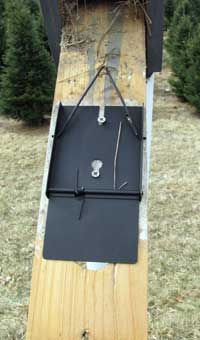 Step 1: Positively identify House Sparrow (HOSP) adults or nests using box.
Step 1: Positively identify House Sparrow (HOSP) adults or nests using box.
- See more photos of HOSP nests, eggs, young.
- Also see photos of “other” brown birds (only a few of which use nestboxes.
The Van Ert inbox trap is a live trap (as it does not kill or harm the bird trapped inside.) Thus, it is safe to use in case another bird investigates the box (sometimes birds that are househunting or are just plain snoopy will check out any box in the area).
Because a native bird could also get trapped by it, it must be monitored hourly. Remove it if you are not going to be able to monitor it hourly (e.g., if you have to leave the area.) It’s easy to put back up when you are able keep an eye on it.
 Step 2: Install the 2 short, flat-headed screws that come with the trap on the inside of the box where the entrance hole is. Position the trap so that, when tripped, it will cover the entrance hole. (Note: these screws can be left in place to allow quick setting of the trap in the future.)
Step 2: Install the 2 short, flat-headed screws that come with the trap on the inside of the box where the entrance hole is. Position the trap so that, when tripped, it will cover the entrance hole. (Note: these screws can be left in place to allow quick setting of the trap in the future.)
Step 3: Place the trap over the screws, tighten to hold in place.
 Step 4: Set the trap by bending the top part down until it sits on the little angled wire. When the bird enters the box, it will step on the triangular wire and trip the trap.
Step 4: Set the trap by bending the top part down until it sits on the little angled wire. When the bird enters the box, it will step on the triangular wire and trip the trap.
Optional: Dangle a piece of grass out of the hole, or put some feathers on the ground in front of the box. This will tempt the HOSP to enter, and trip the trap, especially if they have not begun nest building yet.
Monitor the box at LEAST hourly. (Sometimes, if the nest is active, the HOSP can be caught within minutes.) When the trap is tripped (you will see the orange dot in the entrance hole), immediately go out to remove the bird.
Step 5: Take a mesh laundry bag, and place it over the box. Cinch it at the bottom. (Do NOT use a drycleaning bag as the bird can fly through it. You can also use a strong (heavyweight) clear plastic bag.
Step 6: Open the door to the nestbox.
 Step 7: The HOSP usually flies out into the bag. Grasp it firmly so it can not move.
Step 7: The HOSP usually flies out into the bag. Grasp it firmly so it can not move.
If the bird is NOT a HOSP, release it immediately.
Step 8: Remove the bag, while holding the bird firmly (you may wish to twist it underneath the bird so it can’t get out.)
Step 9: Once you have positively identified it as a HOSP, 1) trim one wing and use it as a decoy in a ground trap, or 2) euthanize it humanely, or 3) trim both its wings and release it.
- If you get the female first, reset the trap immediately to catch the male.
- If you get the male first, the female will sometimes abandon the box (especially if there are no eggs or young), but try resetting it. I usually find if I don’t catch the female the same day, I never do.
Remove all nesting material (under U.S. federal law, it is legal to remove and destroy nests, eggs, young and adult House Sparrows as they are not protected under the Migratory Bird Treaty Act, as they are an introduced invasive species.)
Prevent House Sparrows from using the box in the future. See options.
MORE INFORMATION:
– Bob Orthwein
